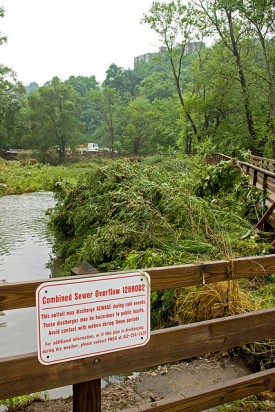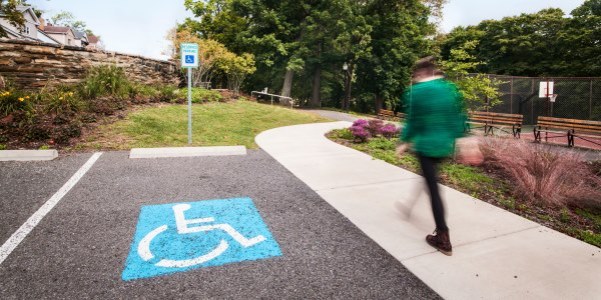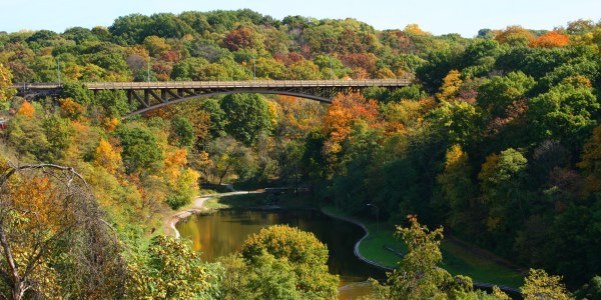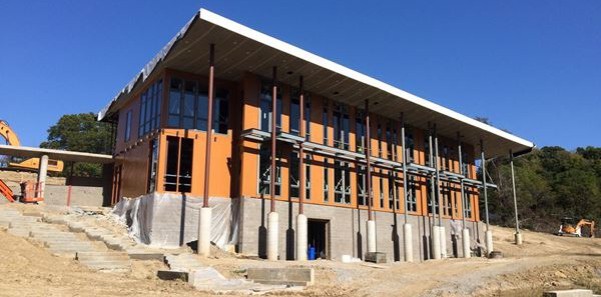When I woke up on my wedding day October 1st – or rather got out of bed after roughly six hours of tossing and turning – the first thing I did was open the weather center app on my i phone. “Cold,” it read. “Rain and wind.” I disbelievingly threw open the hotel curtain only to be confronted with a pall of gray and navy sky. Water snaked down the window as the rain sputtered relentlessly from every direction. The screen of the phone in my trembling hand glowed “42⁰ F”. Five miles away 140 white folding chairs were being delivered at the Memorial Walled Garden in Mellon Park.

Photos by Elle and Arre Photography
When a character in a movie has an epiphany, their life often flashes before their eyes – this was kind of like that. Except I didn’t see my whole life, just the parts where I showed dozens of people around the stunning, newly restored Walled Garden, eagerly watching their faces for the moment of How did I not know this existed. I heard myself pontificating about the beauty of expressing love in nature. I saw my mother and myself standing in the grass on October 1st 2010 at precisely 3:30 in the afternoon to observe the angle of the sun, lest our guests be blinded while observing my marriage. I remember being asked over, and over again, “So what’s your rain plan?” And I would laugh and say, “It doesn’t matter, I’m getting married in that garden.” And so I would, because I wanted to be a part of its magic.

Japanese Anemone in the Walled Garden
I first felt the magic of the Walled Garden in June of 2010, shortly after my engagement and only days after the Pittsburgh Parks Conservancy had completed their restoration. Before the day my mother led me into this space, I had no idea it existed. I was instantly head-over-heels, dizzy in love with it. I couldn’t have known then that almost exactly one year from this moment I would show up for my first day of work as the Parks Conservancy’s new development associate. I didn’t even know they would be hiring. Kismet I believe.
The Memorial Walled Garden in Mellon Park is magical far beyond its most

The restored fountain
obvious qualities – a striking fountain with cherubs and turtles spitting water, beautiful stone paths, and a meticulously manicured garden surrounding a soft carpet of emerald grass. The garden – along with all of the rest of the park – was originally part of the Mellon family’s estate. Constructed in 1929 by the famed landscape architects Vitale and Geiffert, the Walled Garden retains its antique charm thanks to the Parks Conservancy’s commitment to historically accurate restoration in all projects, and careful maintenance by the City. Though it’s in a public park, the garden feels to the people who enter it as though it is a secret beholden only to those inside its walls. This sensation of ownership and belonging it creates is a flawless representation of our City parks’ most gratifying quality – that they do in fact belong to each of its citizens.
 The renovation of the Walled Garden completed in 2010 was done in memory of Ann Katharine Seamans, who loved the garden her whole life. To honor her, a public art installation was added during the restoration. 7:11AM 11.20.1979 79⁰55’W 40⁰27’N is the work of artist Janet Zweig. Each day as the sun goes down, a series of LED lights placed inconspicuously in the grass illuminate the garden’s floor to replicate the constellations of the sky over Mellon Park as they were the day Annie was born. The LED lights that were used were assembled by a crew led by a young man who did the work as his Eagle Scout project.
The renovation of the Walled Garden completed in 2010 was done in memory of Ann Katharine Seamans, who loved the garden her whole life. To honor her, a public art installation was added during the restoration. 7:11AM 11.20.1979 79⁰55’W 40⁰27’N is the work of artist Janet Zweig. Each day as the sun goes down, a series of LED lights placed inconspicuously in the grass illuminate the garden’s floor to replicate the constellations of the sky over Mellon Park as they were the day Annie was born. The LED lights that were used were assembled by a crew led by a young man who did the work as his Eagle Scout project.
When my mother showed me the space she told me about this dedication cautiously, afraid that I would find the association too sad for my wedding, but it had the opposite effect on me. The garden was already beautiful, but it now had meaning, and weight, and art. The Seamans family had taken a personal tragedy and turned it into something that would enrich people’s lives. Through their grief they built
cautiously, afraid that I would find the association too sad for my wedding, but it had the opposite effect on me. The garden was already beautiful, but it now had meaning, and weight, and art. The Seamans family had taken a personal tragedy and turned it into something that would enrich people’s lives. Through their grief they built  something beautiful, and it felt in that moment that they had done it for me. I had the opportunity to say this to Annie’s parents, my voice quaking with an emotion that took me by surprise. This place would forever represent one of the greatest joys of my life.
something beautiful, and it felt in that moment that they had done it for me. I had the opportunity to say this to Annie’s parents, my voice quaking with an emotion that took me by surprise. This place would forever represent one of the greatest joys of my life.
Each of these details is a tree ring in a history I wanted to be a part of.

A friend told us afterward that our wedding was like us – rain or shine
I got the first phone call at 10 am. It was my mother. My maid-of-honor and I had just opened the champagne to cope – there had been other problems, a bridesmaid with the stomach flu, another with a flat tire and still miles away, just to name a few – but despite it all we were laughing. What else was there to do? When I answered, my mother’s voice instantly took the tone of a good Samaritan trying to talk a stranger down off a ledge. She told me that the weather was not going to change, that the reception venue had graciously offered to let us have the ceremony there, they could flip the reception room during cocktail hour.
I was going to get married in that garden.
The hours that followed were a flurry of activity that required more than a few people to abandon their title as “guest” and become “umbrella distributor,” “tent setter-upper,” “wet seat wiper,” etc. People who had never met me donated the use of their pop up tents. At approximately 10:45 am my maid of honor received a text from one of the bridesmaids, it read…”how does Katie feel about rubber rain boots?” I felt very good about rubber rain boots, and so two of my bridesmaids went to Target and purchased seven pairs of black, rainbow polka dotted rubber rain boots. At the same time, in a Target across town, my father unknowingly purchased the matching umbrellas.
As the ceremony drew closer I began to worry to myself that people might not show up. That this might really be crazy. That I might be asking too much for our friends and family to join us while we got married in the cold rain. I consoled myself with the fact that this would be my bridezilla moment. This garden meant a lot to me, and so they would deal with it. It should be noted that my soon to be husband did not even ask if I wanted to move the wedding, he knew I wouldn’t.

“I felt very good about rubber rain boots”
As I walked down the aisle on my father’s arm, everyone I loved was there and smiling beneath a Technicolor canopy. Looking back at people’s pictures as I took that life changing stroll, I noticed that people who had never met sat huddled together under shared umbrellas. Guests told me of the sense of community that immediately developed as people took their seat – drying each other’s chairs with shared towels, taking care not to let the rainwater fall on their neighbor. When I reached the altar I realized that each of the groomsmen had each removed their jacket and given it to the bridesmaid they walked with, Ryin did the same when I met him before the minister. The magic of my garden settled around all of us and I became my husband’s wife.
Many of the moments I loved most about my wedding happened because of the rain. And with my fortitude I had joined the story of a place I love so much. I imagine that a person who was passing by might one day take a friend to that garden and remark, “This one time I saw a girl getting married here in the rain, with a smile on her face.”

Elle and Arre Photography
Kathleen (McGuire) Gaines is a development associate for the Pittsburgh Parks Conservancy.
Permitting for the Walled Garden is handled by the City – the permitting office can be reached at 412-255-2370. More info about permits is here. To learn more about the restoration of the garden and its wonderful public art visit our website here.
All photographs taken by Elle and Arre Photography.









 cautiously, afraid that I would find the association too sad for my wedding, but it had the opposite effect on me. The garden was already beautiful, but it now had meaning, and weight, and art. The Seamans family had taken a personal tragedy and turned it into something that would enrich people’s lives. Through their grief they built
cautiously, afraid that I would find the association too sad for my wedding, but it had the opposite effect on me. The garden was already beautiful, but it now had meaning, and weight, and art. The Seamans family had taken a personal tragedy and turned it into something that would enrich people’s lives. Through their grief they built  something beautiful, and it felt in that moment that they had done it for me. I had the opportunity to say this to Annie’s parents, my voice quaking with an emotion that took me by surprise. This place would forever represent one of the greatest joys of my life.
something beautiful, and it felt in that moment that they had done it for me. I had the opportunity to say this to Annie’s parents, my voice quaking with an emotion that took me by surprise. This place would forever represent one of the greatest joys of my life. 


 Do you ever wonder what happens to water that falls on the city during storms? At first glance, it seems to just disappear down drainspouts and culverts. In truth, the fate of rainfall and snowmelt that occurs in Pittsburgh has effects that reach beyond our backyards and drains.
Do you ever wonder what happens to water that falls on the city during storms? At first glance, it seems to just disappear down drainspouts and culverts. In truth, the fate of rainfall and snowmelt that occurs in Pittsburgh has effects that reach beyond our backyards and drains. One of the things I love about runoff and hydrology is that EVERYWHERE on land is part of a watershed. When it rains, or when snow melts, water anywhere on Earth has a path it will follow, either to the ocean, or sometimes to a salt lake or salt flat. Water that falls on Pittsburgh and isn’t used or evaporated ends up in the Gulf of Mexico! That is about 1000 miles by road but significantly further along the twisty Ohio and Mississippi rivers. And every bit of that huge river (except rain that happens to fall in the river itself) comes from little tiny tributaries somewhere upstream (including those that travel underground in the form of groundwater).
One of the things I love about runoff and hydrology is that EVERYWHERE on land is part of a watershed. When it rains, or when snow melts, water anywhere on Earth has a path it will follow, either to the ocean, or sometimes to a salt lake or salt flat. Water that falls on Pittsburgh and isn’t used or evaporated ends up in the Gulf of Mexico! That is about 1000 miles by road but significantly further along the twisty Ohio and Mississippi rivers. And every bit of that huge river (except rain that happens to fall in the river itself) comes from little tiny tributaries somewhere upstream (including those that travel underground in the form of groundwater).


